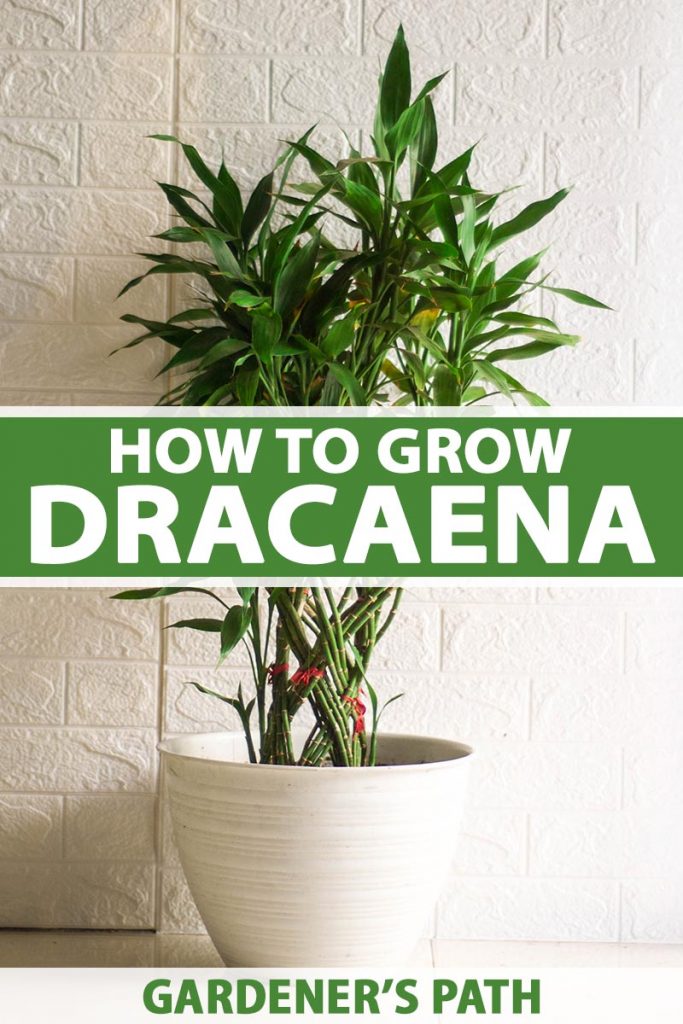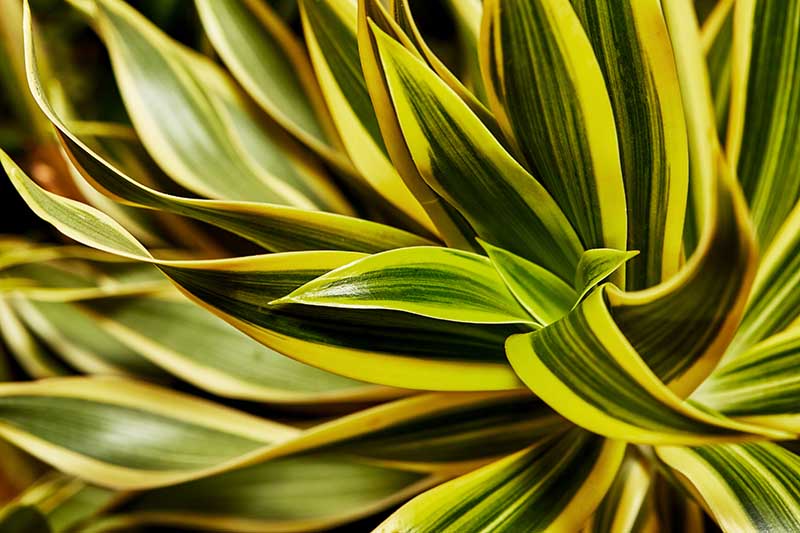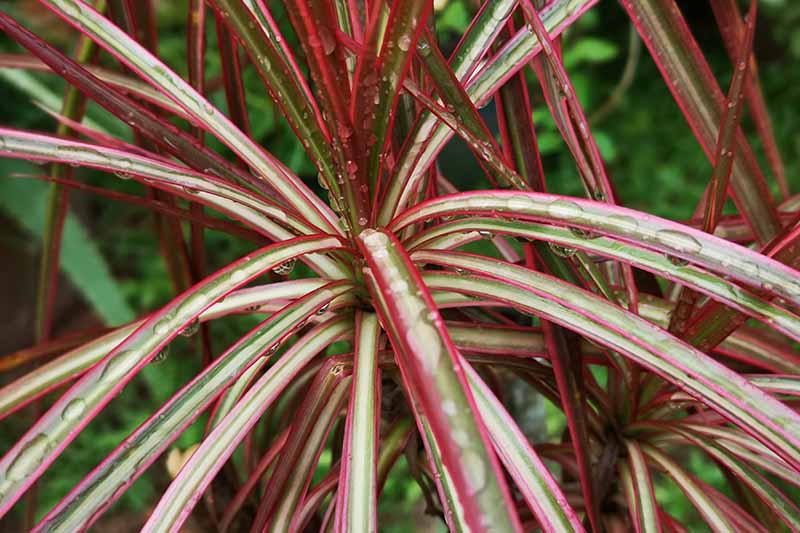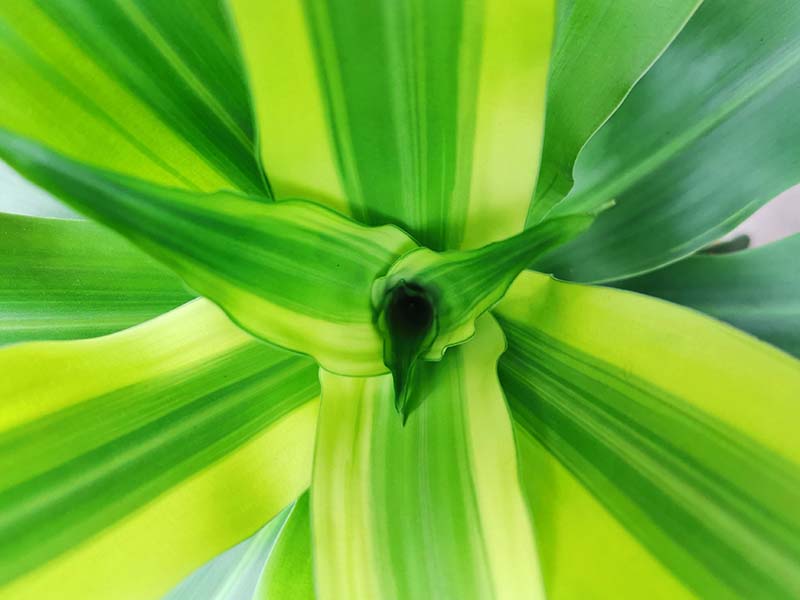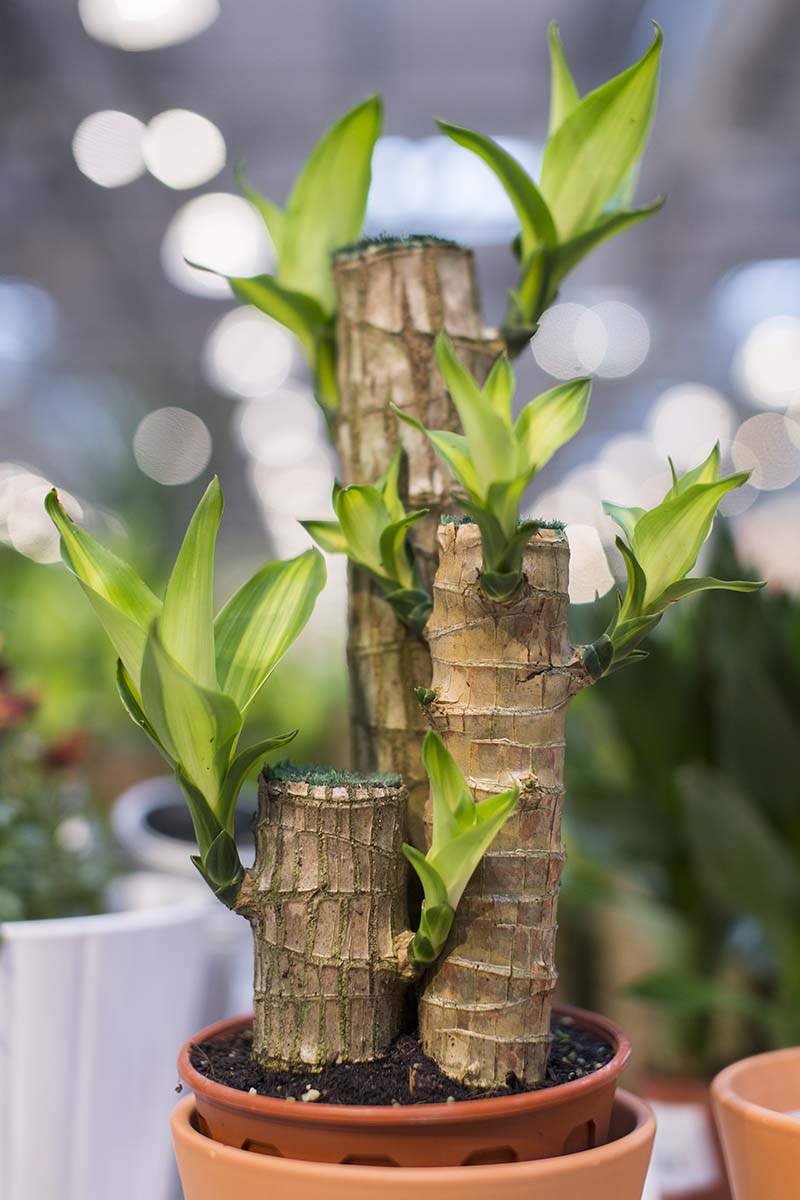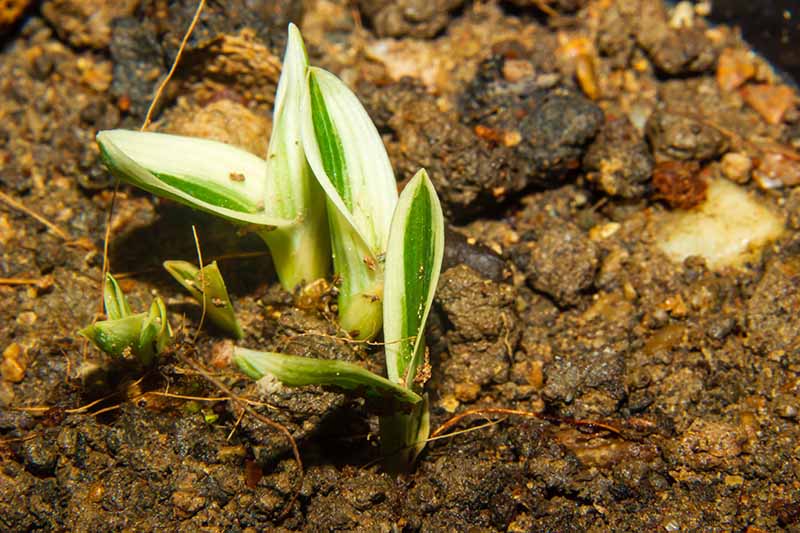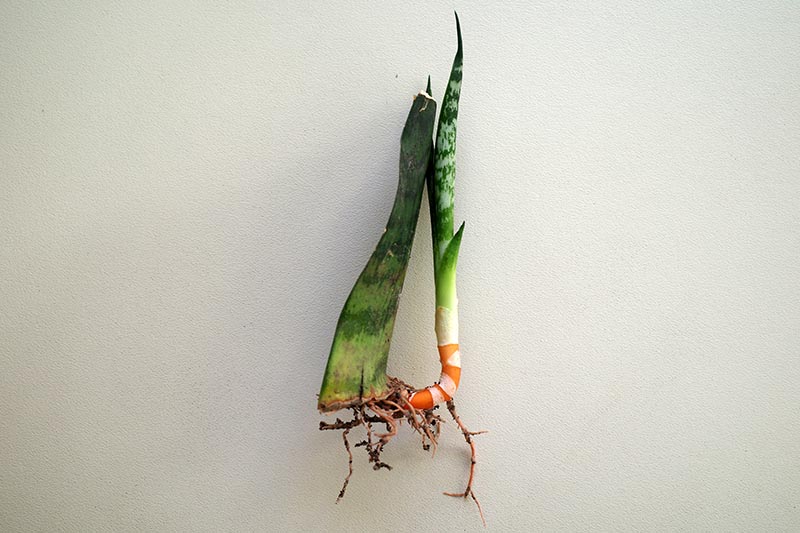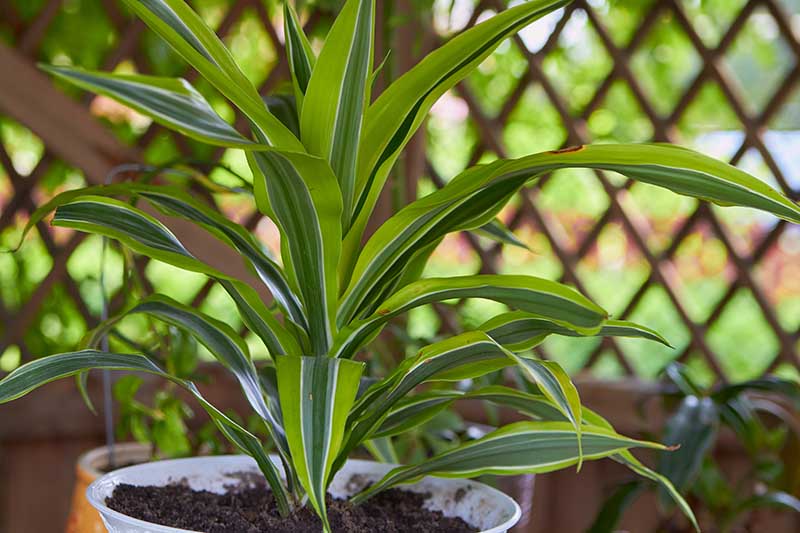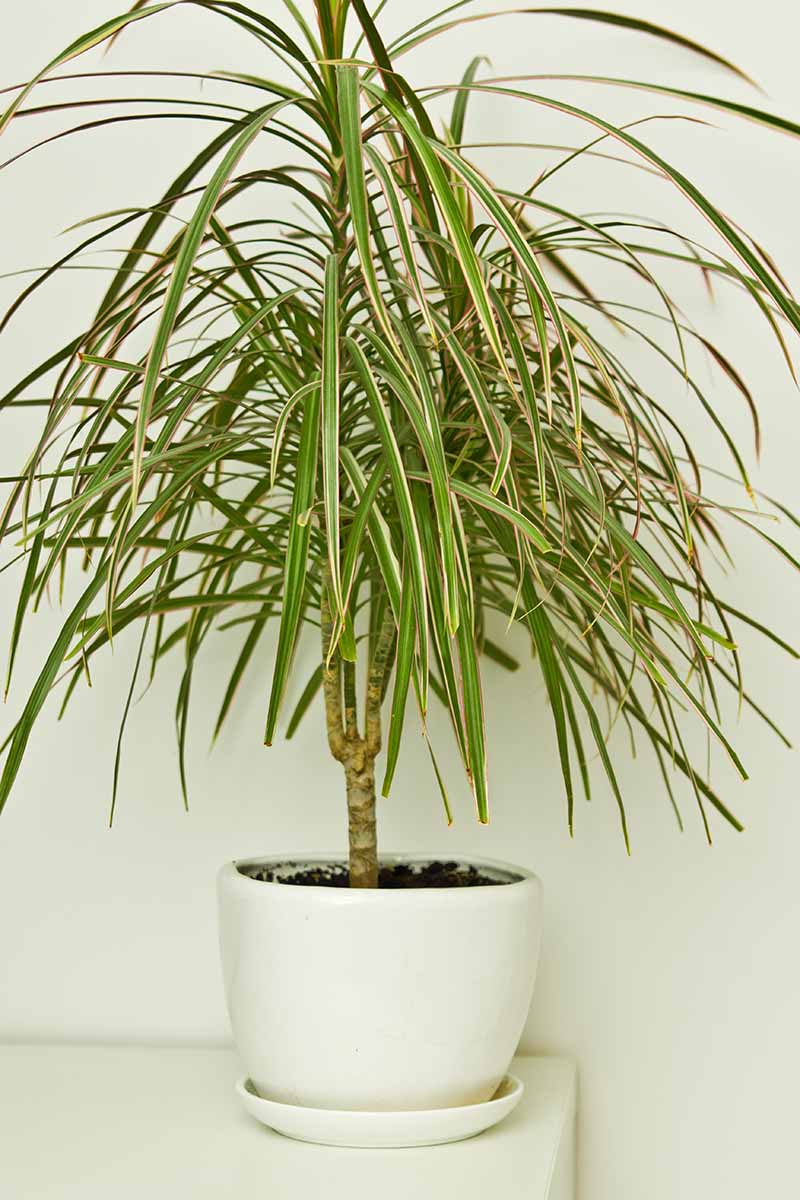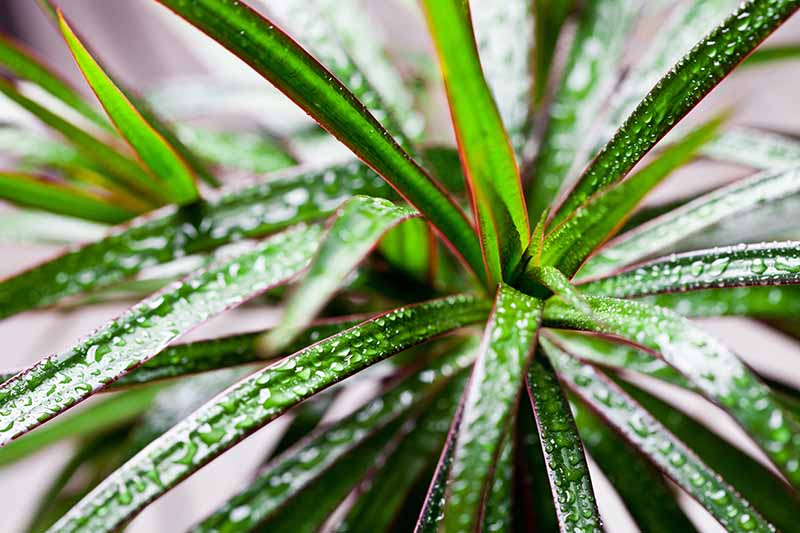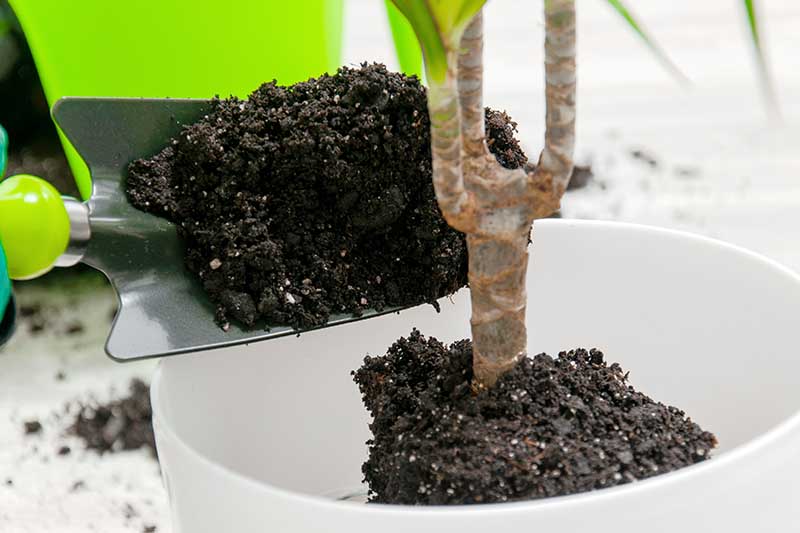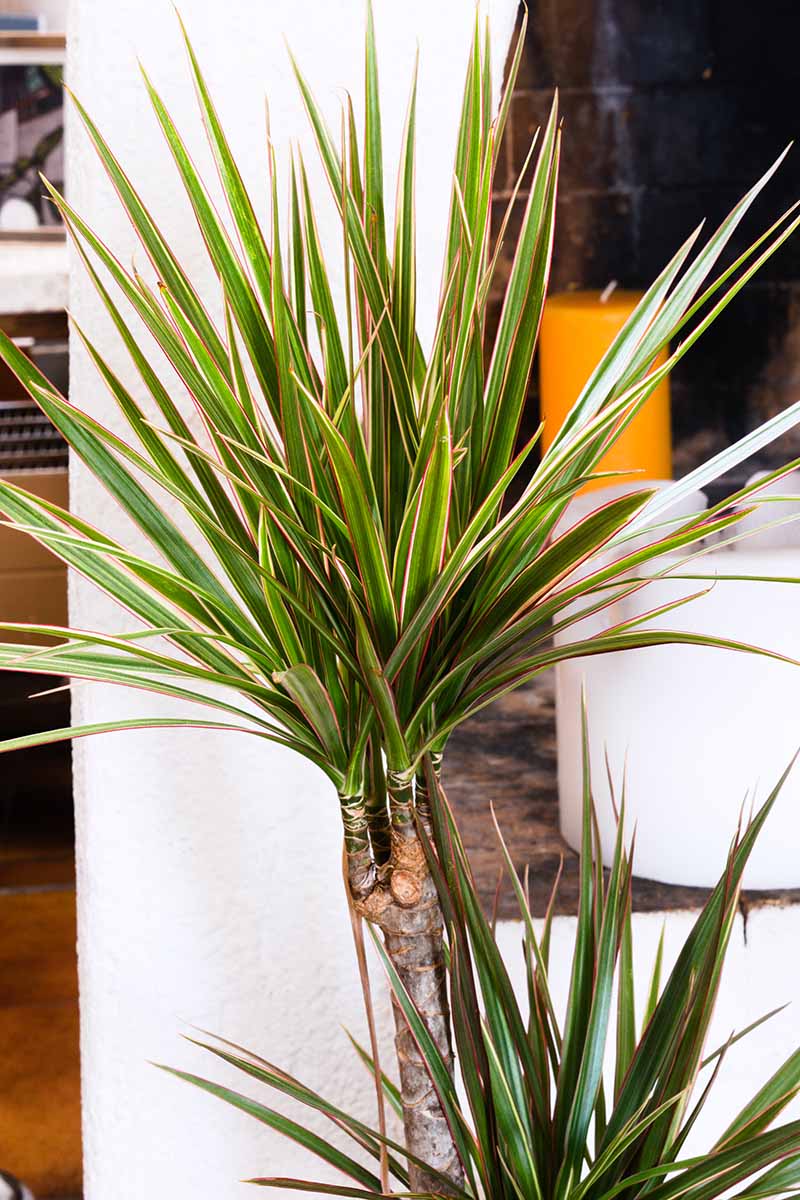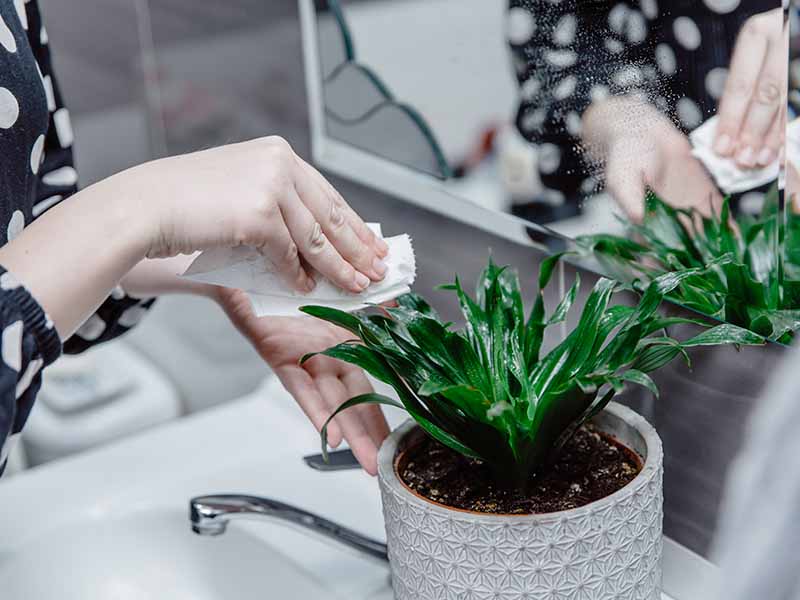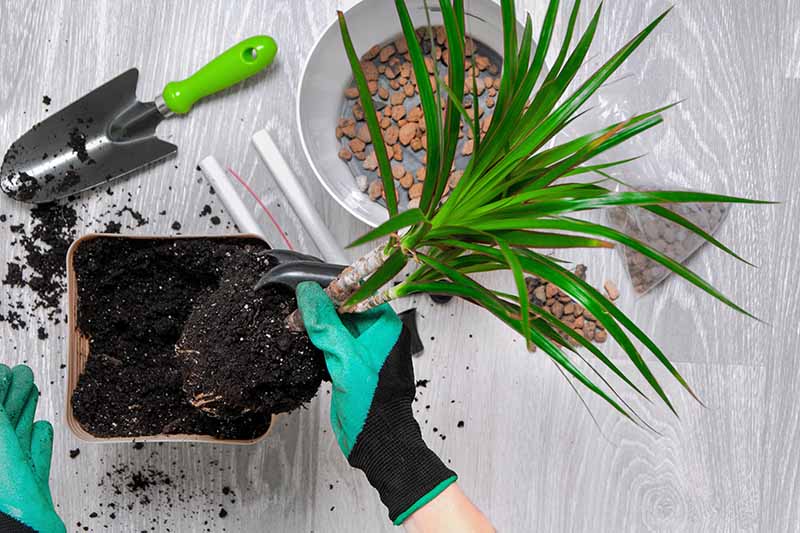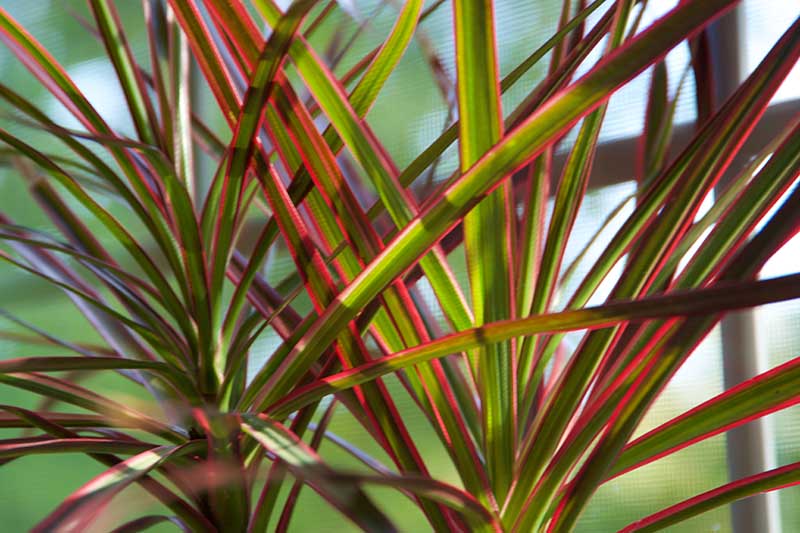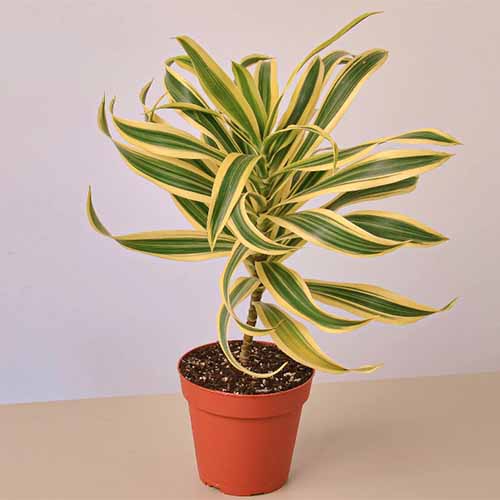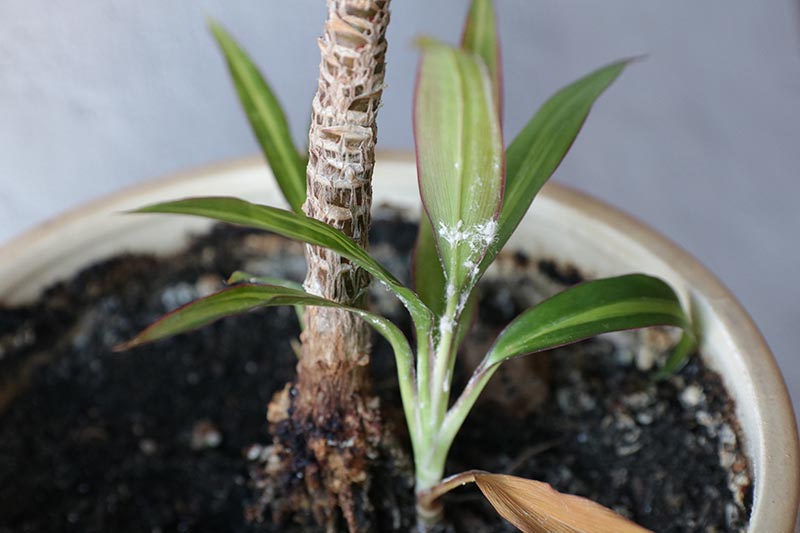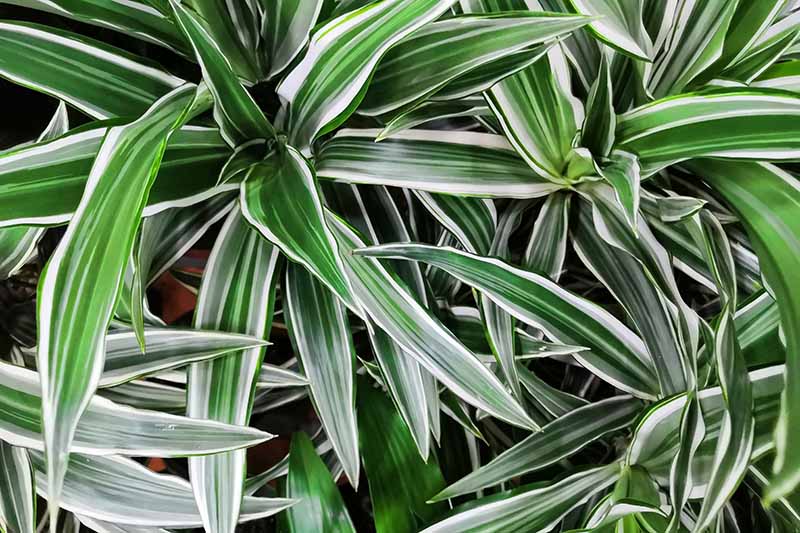Dracaena houseplants are ideal for busy, absentminded gardeners. They are so easy to take care of, and they are likely to withstand occasional neglect. With many different species available in varying sizes and colors, you can find the perfect option for any space. We link to vendors to help you find relevant products. If you buy from one of our links, we may earn a commission.
Cultivation and History
Part of the Asparagaceae family, the Dracaena genus includes approximately 120 species, varying in size from small houseplants to larger shrubs and trees. But you may note that some sources claim there are in fact as few as 40 named species in the genus.
This wide range is partially due to the fact that there is an ongoing debate as what exactly should be classified in this genus. Also worth noting, they often are confused with Cordyline plants, though these are in fact distinct. One clear way to tell the difference is to look at the roots. Cordylines have white roots, while dracaena roots are orange in color. Most of these species are native to the tropics, in parts of Africa, southern Asia, and northern Australia. A couple are endemic to South America.
While many dracaena trees can grow over 10 feet tall, it is generally the smaller shrubs that are cultivated as indoor houseplants. These can be found in a wide range of shapes, sizes, and colors, and many popular types feature dazzlingly colorful striped foliage. Dracaenas have been part of human culture many centuries and was officially named in the 1700s after the ancient Greek Drakaina, a mythical female spirit dragon with humanlike features.
Some varieties contain a red resin in their stems known as “dragon’s blood,” which has been used for thousands of years to make dye, incense, and medicine. Since the 17th century, it has also been used to make varnish for violins and other string instruments, and is often used in stains and wood polishes. Dracaena began to appear ornamentally in Europe in the 1800s, and by the end of the century had become a relatively common houseplant.
Propagation
Dracaenas are slow growers, best started from cuttings or purchased as nursery stock.
From Cuttings
The first method that I’ll cover, top cutting, involves snipping off the entire top just below the leaf line, being sure to include at least a few nodes on the stem. Don’t worry about harming the parent plant – it should begin sprouting new leaves very quickly.
You can choose to either plant the cutting directly in a pot of moist potting soil, or in a translucent vase filled about a quarter of the way with cool water. Be sure to choose a vase or pot that’s large enough, so the cutting does not tip over. Planting in water first speeds up the process a bit and also is a fun way to monitor the progress of the root development. Once you have planted the cutting, set the vase or pot in a warm spot (about 65-75°F) that receives indirect sunlight. The first signs of root growth should appear in about a week or two. If you are using the water method, change the water every few days, checking for white nodules which will develop into roots.
If cuttings are planted in soil, you can check for root growth by gently tugging on the stem. If roots have developed, you should feel resistance. When the nodules have developed into roots about an inch long, it’s time to transplant the cutting into a two- to four-inch pot with good drainage. Fill with a porous soil mix that’s rich in organic matter; one that’s formulated for indoor houseplants will work well. Be sure to completely bury the roots.
A second method, rooting stem cuttings, allows you to propagate many cuttings at once. Start by cutting off the top just as you would for a top cutting, but this time, remove more of the stem along with it. Leave at least half of the stem of the parent plant intact so it can grow back. Cut the stem into sections, making sure each contains at least a few nodes. Plant each stem segment in soil or water, with the base facing down to maintain its original orientation, following the same instructions described above. When plants become root bound, move them to larger containers. See the pruning and maintenance section below for more detailed instructions to transplant your dracaena to a larger pot.
How to Grow
These plants are incredibly easy to grow. Just set them somewhere with filtered light, such as a bright window with a sheer curtain.
Avoid areas that receive direct sunlight, as it could burn the foliage. They can tolerate low light but medium, indirect light is best. They can tolerate a range of temperatures, with a preference for indoor temperatures ranging from 60 to 70°F during the day, and a bit colder at night. Ingestion can cause vomiting, diarrhea, weight loss, hypersalivation, and other unpleasant symptoms. While considered nontoxic to humans, it still should not be consumed. It is best to keep this plant out of reach of all pets and children.
Just be sure to avoid placing them in locations where the temperature may dip below 55°F, and keep plants out of range of heating or cooling vents, to avoid cold drafts or blasts of heat. Dracaena can also be grown outdoors year-round in USDA Hardiness Zones 9 to 11.
Watering
Be sure to water with purified water or rainwater, as dracaenas are sensitive to fluoride salts common in tap water.
Keep the soil moist but never soggy, always letting the top of the soil dry out completely between waterings. Too much moisture or poor drainage can cause leaves to yellow and droop, and will likely lead to root rot. Though adaptable, these tropical plants thrive in climates with high humidity. You can increase the humidity indoors by setting a shallow tray filled with small rocks underneath the pot, and adding enough water to barely cover the rocks. The evaporating water will help provide additional moisture. It is also helpful to mist the foliage every few days.
Fertilizing
These slow-growing plants don’t require much in the way of fertilizer, and I refrain from feeding mine much at all. Instead, I opt to keep an eye on them for signs of distress, such as yellowing or browning of leaves, which could indicate a nutrient deficiency.
If you like, you can choose to feed your dracaena about once a month during the spring and summer with a balanced liquid fertilizer diluted to half strength. Some gardeners do this more sparingly, feeding once in the spring and again at the end of summer. Do not feed during the winter, when growth naturally slows down. Top dressing or repotting in new soil every couple of years can also help to keep your plants healthy and well fed, with plenty of available nutrients.
Growing Tips
Choose a location with filtered light and 60-70°F daytime temperatures. Never let temperatures drop below 55°F. Water with purified or filtered water, allowing the soil surface to dry between waterings. Place a shallow tray of rocks and water underneath pots to increase humidity.
Pruning and Maintenance
As a dracaena plant grows, it will naturally shed its bottom leaves. Pruning may be done at any time to remove damaged canes and to prevent them from getting out of control. Some species can grow up to 10 feet tall, so pruning may be a necessity to keep the size of indoor trees in check.
Luckily, this genus is very tolerant of pruning. You can cut healthy plants back to any height without worry of causing harm. You can also prune them as bonsai plants. To prune, simply use a sharp blade and cut any cane you wish to remove. Make your cut at a 45-degree angle to avoid water damage. You can also prune out any leaves that have turned brown or appear to be dead or dying. Brown tips or sections may be trimmed off without removing the whole leaf. Find more dracaena pruning tips here. When a section of the stalk is removed, new growth will usually appear below the cut a few weeks later. If you like, you can also propagate healthy canes that you’ve removed to start a new plant! It is also a good idea to occasionally dust off the leaves with a damp cloth. Dust can block sunlight, inhibiting photosynthesis.
Repot dracaenas every couple of years to help replenish soil nutrients, as well as to prevent plants from becoming root bound. Select a container that’s two inches larger than the current pot. A day or so before you plan to repot, water well so that the soil is damp. This will help hold everything together when transplanting. Carefully slide the plant out of the container, cutting away any roots that may have started growing out of the drainage holes. Running a knife around the inner edge of the container may help to loosen the plant if it’s stuck. Place the root ball into the new pot, surrounded with moist potting soil. Water thoroughly.
If plants are very large and heavy or unwieldy, instead of repotting, you can replace the top few inches of soil with new soil instead. Top dressing at least one a year helps to restore nutrients without disturbing the roots. Fluoride toxicity is another potential problem to keep on your radar. Depending on the species, this may be indicated by browning in the white stripes on leaves, by yellowing and dying leaf tips, or by dead brown spots with bright yellow rings that appear along leaf margins. Be sure to avoid using fluoridated water on your plants and maintain a soil pH between 6.0 and 6.5. You can learn more about soil testing here. If you suspect fluoride toxicity, try repotting in fresh soil.
Species to Select
There are many species and unique cultivars of dracaena that make wonderful houseplants.
You should be able to locate the more popular species at your local nursery, or even better, from a friend if they’re willing to give you a cutting. For added convenience, you can even order dracaena plants online. Get started with the following recommended varieties:
Dracaena Fragrans var. Massangeana (Corn Plant, Mass Cane)
A common indoor plant, this variety tends to be the most affordable of the dracaenas. It is also very slow growing, low maintenance, and can tolerate lower light than other varieties, making it a great choice for your indoor space. D. fragrans var. massangeana It is characterized by long glossy green leaves with bright yellow central stripes and thick, woody canes.
Dracaena Marginata (Dragon Tree)
A great focal point for an indoor space, this striking evergreen tree can reach heights of around six feet indoors, though it is slow growing and it may take 10 years or so to reach this height. The dragon tree has curved stalks and slim, arching green leaves with red edges.
Dragon Tree One of the most tolerant of the dracaena species, it is a very popular choice for indoor growing. Home Depot also offers D. marginata in six-inch pots.
Dracaena Reflexa (Song of India, Song of Jamaica)
Perhaps the most common species grown as a houseplant, D. reflexa is popular for its distinctly colorful foliage. The pointed, narrow, deep green leaves have bright yellow stripes. It is highly adaptable and makes a great choice for indoor growing.
Song of India Song of India (aka Song of Jamaica) plants are available for purchase from Walmart in four-inch pots.
Managing Pests and Disease
You won’t have to worry too much about potential issues plaguing these incredibly easy to care for plants, but there are a few pests and diseases that can come up, and it is always good to be prepared. We present our favorite varieties in our supplemental guide, “7 Best Types of Dracaena to Grow at Home.”
Insects
There are a few insects that enjoy feeding on dracaena foliage. Luckily, pests are generally pretty easy to keep under control, as long as you remember to check on your plants occasionally.
Aphids
These tiny bugs may form clusters on the plant, sucking juices from the stems, leaves, and buds. Infestations can cause wilting and reduced vigor. You can read more about addressing a problem with aphids here.
Mealybugs and Scale Insects
Wingless insects with a waxy coat, mealybugs congregate together in what resembles a cotton-like mass, and scale insects have brown bodies with a cotton-like coating. They also produce fuzzy white egg sacs, which can be found attached to plants.
These pests can be found hiding in protected areas such as leaf axils. Signs of infestation include stunted growth and leaf drop. Mealybugs, scale, and aphids all secrete honeydew as well, which attracts ants. Mild infestations can be controlled by spraying plants regularly with a strong stream of water. Spray every few days while pests are present. Heavy infestations can be controlled with a homemade insecticidal soap, or neem oil. You can make a simple insecticidal soap for use on these pests by combining a tablespoon of biodegradable liquid soap with a quart of warm water. You can add a little bit of garlic or hot pepper to the mixture to further deter pests. Spray the tops and bottoms of the leaves daily until the infestation is under control. Find tips on combating scale insects here or find more information on controlling mealybugs here.
Spider Mites
Almost too small to see, spider mites from the Tetranychidae family may appear as tiny moving spots on the leaves. They cause brown and yellow spotting on foliage, and you may also notice thin webbing. These pests prefer dry conditions and can often be found on plants that are given too little water. Spraying the foliage with a strong stream of water may knock off the mites. Neem oil can also be applied when necessary. Find more information on identifying and controlling spider mites here.
Disease
While caring for dracaena is relatively hands-off, it is a good idea to give plants an occasional thorough exam to ensure that they stay disease free.
Most pests and diseases can be kept in check by providing minimally adequate growing conditions – no need to fuss too much if you’ve covered the basics!
Soft Rot
This is a bacterial disease caused by Erwinia carotovora that leads to brown soft spots on roots and on the base of the stem accompanied by an offensive odor. There is no treatment for soft rot, so prevention is best. Encourage good drainage and avoid overwatering. You can also look for plants that are certified disease free when you make your selections. Infected plants should be discarded.
Leaf Spot
Caused by Fusarium moniliforme fungi, this infection is common on many types of dracaenas. This disease causes spots to form on young leaves. The spots range in size and color, and often look reddish brown or tan with yellow rings. Control leaf spot by watering at the base of the plant – not overhead – and discarding excess water in the saucers under your plants after watering.
And with so many different species to choose from, you will never get bored! What dracaena species do you like to grow? Share your favorites in the comments section below, and feel free to share a picture! And for more inspiration, why not learn about some other houseplants next? These guides have got you covered:
How to Grow and Care for Prayer Plants How to Grow Christmas Carol Aloe: Anti-Sting and Makes You Sing! How to Grow and Care for Spider Plants
© Ask the Experts, LLC. ALL RIGHTS RESERVED. See our TOS for more details. Product photos via American Plant Exchange, Home Depot, and Walmart. Uncredited photos: Shutterstock. With additional writing and editing by Allison Sidhu.
